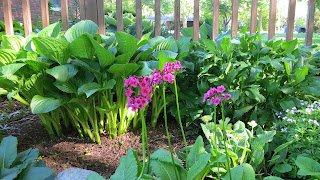 |
| Primula veris, the cowslip |
But there are many species of Primula, and many cultivars and hybrids. The common garden primroses most often seen in cultivation are mostly "polyanthus", which are descended from hybrids of P. veris, P. vulgaris (the true primrose), and P. elatior (the oxlip). Another species, P. juliae, has added more color range.
Because I was so enamored of primulas, I chose a garden primrose as my gravatar for this blog. The picture is not of a "buttercup" but of a yellow polyanthus primrose that has been a sturdy guest of my garden for many years now. It was given to me by a friend, which is the way primroses often get passed around.
 | |
| Grace's Red |
 |
| Grace's White |
I have grown many other types of Primula that I have started from seed. This is a rather laborious process but the surest way to get many of them, since they don't all divide well and seed-starting is the way to get a wide range of types. I've ordered many different ones from the North American Rock Garden Society seed exchange. I was able to start most of them, but many proved not to be hardy here in Michigan.
Long before I ever grew any Primula, I studied them in biology classes. They are the classic example of self-sterile flowers. Most of them have obligate outbreeding, that is, cannot pollinate themselves. This is done both with genes and because the style and stamens are designed so that it is structurally impossible. Two types of flowers, pin (long style) and thrum (short style) exist; this is called heterostyly. Hand pollination is usually necessary to obtain seeds in the garden. Here is a guide to hand pollination of primulas.
But a very few species do develop homostyly and can produce seed. I inadvertently started a colony of candelabra primroses in my garden. I'm not sure of the species or cultivar because I had tried a number of different species in that bed the year before. It may even be a self-sustaining new hybrid.
A rather perverse charm of Primula is that they are often short-lived if not cultivated very carefully. They require top-dressing with compost and good fertility, not to mention water and protection from hot sun. So I've lost many of them, and saved others through a last-ditch effort. Now I'm going to be trying to recover some of my favorites by starting seed as early as December, with long periods of chilling, warming, waiting, and slowly transferring the tiny plantlets until they are ready to plant in the garden. I won't see any flowers from this year's seed-starting until next year. But that is the price of having a lovely show of primroses in the early spring.
Note: There is a second post on Primula in the garden, Primula Odyssey. Other posts on this subject will be labelled "Buttercup" for search purposes.















